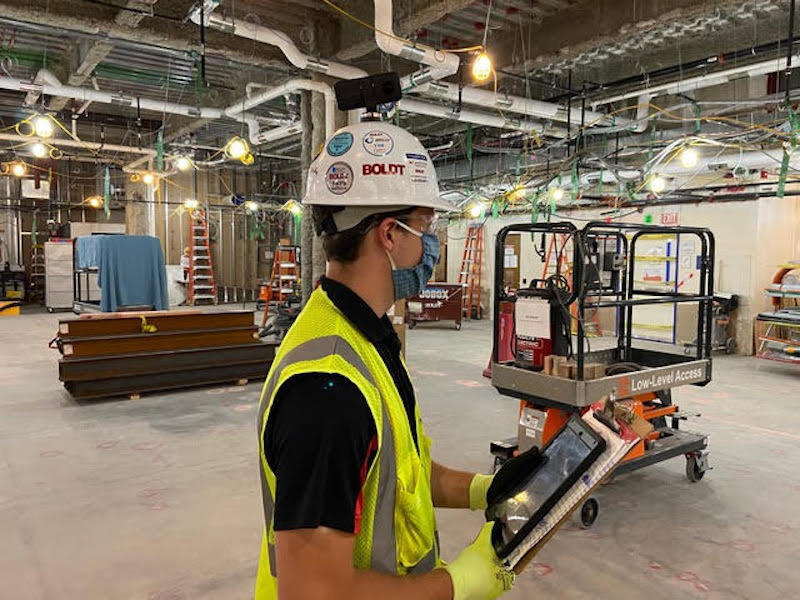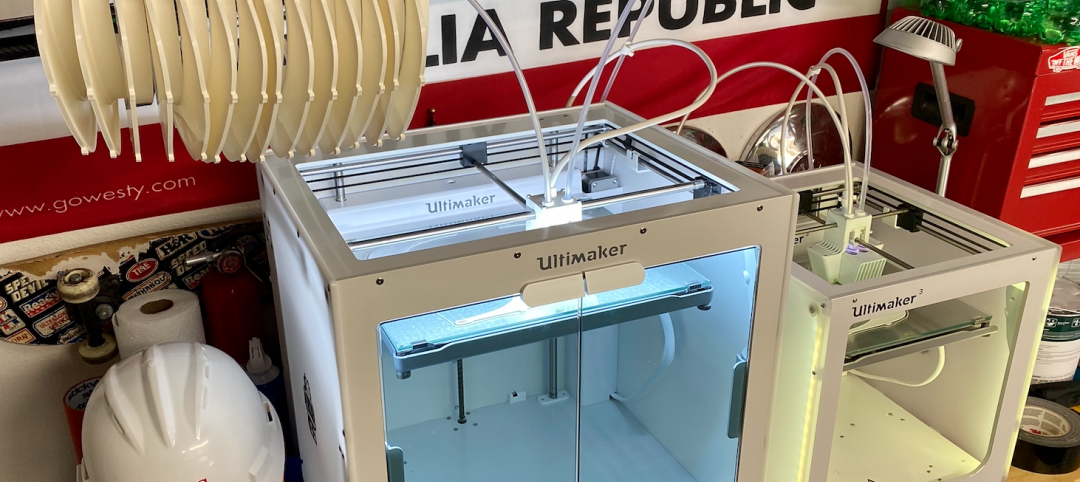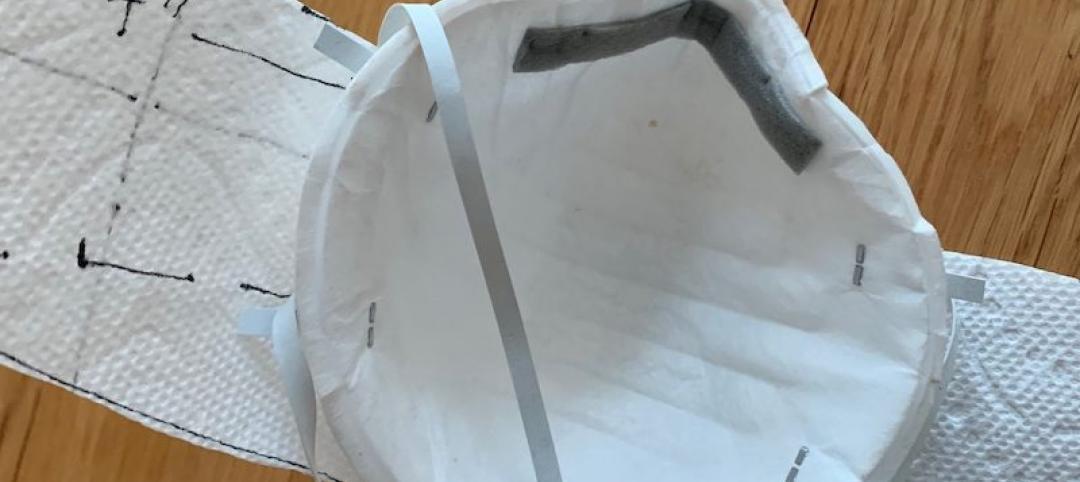APPLETON, Wis. - June 22, 2020 – When physical distancing put a wrench in the personalized give and take of building complicated structures, The Boldt Compoany relied on innovation and a creative use of technology to reopen its 14 national offices and dozens of jobsites.
The company created a task force to address facilities and technology, then tapped experts in its own technical services division to pull together a center of excellence to address reopening. “We quickly accessed the best thinking in the industry to address all the issues surrounding reopening,” said Will Lichtig, Boldt’s Executive Vice President, Performance & Innovation.
The task force identified issues for operations, safety, technology, different geographic markets, and assigned a leader for each topic. Team members identified issues such as split work schedules, team members who would continue to work from home, varying state requirements, and even the mood of their teams. “We developed a set of guiding principles within our reopening framework to provide direction for our operating groups to figure out how they want to function,” Lichtig said.
TECHNOLOGY LEADS THE WAY ON REOPENING JOBSITES AND COMPANY OFFICES
Technology quickly led the way to address safety issues and physical distancing guidelines.
“The pandemic has been a catalyst for forcing change via technology,” said Dave Much, Boldt’s Director of Emerging Technologies. “Because we’re using Microsoft Teams, it was seamless for most of our workforce to go home and not worry about connecting to work.” According to Much, in the last 90 days Boldt employees nationwide engaged in:
- 335,224 chat messages
- 15,517 video or telephone meetings
- 17,197 participants in those meetings
On construction jobsites, there were even more difficult problems to address.
In most states, construction was declared an essential industry, so early in the pandemic Boldt created a health screening system for anyone entering a jobsite or office. Workers, subcontractors, even customers were required to fill out a daily health assessment form and have their temperature screened. But the individual pieces of paper started piling up and the number of subcontractors on multiple job sites added to the paper.
Dan Wagner, a Boldt Superintendent in California, found himself juggling 150 pieces of paper a day and trying to do it while working remotely. “A paper form requires someone to touch it, put it in a bin, and keep as a record,” Wagner said. “The very nature of the process was counter to achieving a seamless process that doesn’t spread the virus.”
That’s when Wagner got on a videoconference and asked if the Boldt IT group could design a process based on smartphones. Using Microsoft Forms, Boldt IT created a process in which anyone entering a jobsite scans a QR code and is immediately taken to an online survey for health assessment. If an individual’s answers raise a potential COVID-19 concern, the screen indicates the user is denied jobsite access and the survey is immediately referred to the superintendent and safety.
“The system notifies us in seconds,” Wagner said. “It makes our safety managers lives so much easier because they can manage information and get the reports while working remotely.” He added that most people who don't pass the assessment do so because they made a data entry error.
“We had a conceptual conversation on a Monday and had a prototype in testing by the following Friday,” Much said. In two weeks, the California office was using the process, and the system is now in place at Boldt offices and jobsites nationwide.
360-DEGREE CAMERA VISUALIZES CHILDREN'S HOSPITAL JOBSITE
When Wisconsin issued safe-at-home orders in March, one of the most complicated jobsites was impacted. Boldt is constructing a six-story, 237,000 square-foot addition to house specialty clinics and surgical services at Children’s Hospital of Wisconsin. Work was in progress for wall framing and in-wall rough-in for the finishing stage of construction, and on any given day there were about 225 people on the jobsite. As an essential industry, construction crews stayed on the site, but support services, construction management, and facilities executives from Children’s were working from home.
“Our architects in Chicago weren’t coming up, and much of our project team was working remotely,” said Scot Lauwasser, Boldt Project Manager. “We started tying up our resources with video conferences and having a hard time sending site photos to all parties.”
That’s when Scot remembered a product called OpenSpace—a 360-degree camera mounted on a hardhat that takes photos every half-second as a person walks through a construction site. “It’s sort of like Google street view for construction projects,” Lauwasser said. The photos are automatically uploaded to a website and map directly onto site plans, floor plan layouts, even computerized BIM models of the building. Photos and floor plans are accessible by anyone with an Internet connection.
“We walk the jobsite once or twice a week,” Lauwasser said. “Customers and construction partners can log in at any time and immediately see the progress of the job based on the timeline.”
OFFICE REOPENINGS GO BEYOND BASIC TEMPERATURE CHECKS
In planning to reopen offices nationwide, the core planning team again looked to technology to provide accurate health screenings and do so quickly and accurately. Much suggested going one step beyond thermal temperature cameras and is looking at a system that provides temperature checks, uses facial recognition, and can be linked into each building’s security system. Team members who pass the temperature scan can be automatically admitted into the building in one scan.
“Handheld thermometers aren’t always accurate, and they require a person be within six feet of the individual,” Much said. “We were looking for a solution that provided quality data.” The system is currently being tested at the firm’s headquarters in Appleton, Wis.
For more information, please visit www.boldt.com.
TASK FORCE FLATTENS THE DECISION-MAKING CURVE
To manage the rapid changes posed by the pandemic, Boldt leadership realized a hierarchical structure was not nimble enough to address the crisis. “We needed a structure that could deal with a cycle time that was faster than a hierarchical decision tree,” said Lichtig.
Lichtig was charged with establishing a framework that would provide rapid decision making, disseminate information quickly, and benefit from the knowledge of a wide base of people. Boldt established a COVID-19 core group, then created a task force that touched all corners of the company.
“We weren’t dictated by position, we identified people who could make a difference in our organization and be good communicators within and without of the task force so information flowed seamlessly,” Lichtig said. Meetings occurred daily, and often included as many as 50 people on video conference calls.
By flattening the decision tree, Boldt was able to pivot quickly to keep essential jobsites functioning, and keep support people safer-at-home. When reopening discussions started, the framework was in place to move rapidly and safely. The team has three goals:
- Keep the coronavirus out of offices and job sites
- Prevent the spread of the virus
- Keep all locations clean
Each office was asked to implement a range of best practices to support these goals in areas that touched on parking, building entrances/exits, office layout, plumbing, HVAC, and other areas. “We were clear with our teams on the ground rules, to define limits of authority, and to enable them to execute without checking back with headquarters,” Lichtig said.
As a result, while goals are the same, implementation will differ from office to office. The process has helped the organization in three primary areas. “For our immediate needs it has helped us bring people back into the office, especially those who want to or need to be in an office setting,” Lichtig said. “In the next 3-6 months it will address how we will sustain our approach and beyond that, it will help us determine what the office of the future will look like,” Lichtig said.
THE BOLDT COMPANY: EMPLOYING INTEGRATED LEAN PROJECT DELIVERY
The Boldt Company is one of the leading construction management firms in the United States. The firm is a nationally recognized leader in Integrated Lean Project Delivery in the healthcare, industrial, commercial, and energy and power sectors. Boldt is headquartered in Appleton, Wis., and has 14 offices nationwide.
Related Stories
Coronavirus | Apr 2, 2020
COVID-19: HMC Architects using 3D Printers to make face shields for healthcare workers
HMC staff is producing 3D-printed parts from their homes as they self-isolate.
Coronavirus | Apr 2, 2020
COVID-19: CannonDesign initiates industry coalition to make masks for healthcare providers
Coalition formed to make DIY face masks for healthcare workers in COVID-19 settings.
Coronavirus | Apr 2, 2020
As virus spreads across North America, software providers step up with cost-free offerings
The goal is to keep construction projects moving forward at a time when jobs are being postponed or canceled.
Coronavirus | Apr 2, 2020
SBA and Treasury begin effort to distribute $349 billion in emergency small business capital
The new loan program will help small businesses with their payroll and other business operating expenses.
Coronavirus | Apr 2, 2020
New webinar explains how AIA Contract Documents can address business disruptions due to Covid-19
The webinar was recorded March 27.
Coronavirus | Apr 2, 2020
Informed by its latest Crane Index, Rider Levett Bucknall anticipates the effect of coronavirus on the construction industry
While total crane count holds steady, turbulent economic conditions indicate a recession-based drop in construction costs.
Coronavirus | Apr 1, 2020
How is the coronavirus outbreak impacting your firm's projects?
Please take BD+C's three-minute poll on the AEC business impacts from the coronavirus outbreak.
Coronavirus | Apr 1, 2020
Opinion: What can we learn from the coronavirus pandemic?
The coronavirus pandemic will soon end, soon be in the rear-view mirror, but we can still take lessons learned as directions for going forward.
Coronavirus | Apr 1, 2020
Three reasons you should keep sewing face masks (as long as you follow simple best practices)
Here are three reasons to encourage sewists coast to coast to keep their foot on the pedal.
Coronavirus | Apr 1, 2020
TLC’s Michael Sheerin offers guidance on ventilation in COVID-19 healthcare settings
Ventilation engineering guidance for COVID-19 patient rooms

















